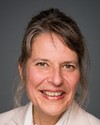Madam Chair, honourable members of the committee, thank you very much for this opportunity to speak with you today.
I'm joined by my colleague, Serge Villemure,
who is in charge of NSERC's scholarships and fellowships program.
I think my colleagues here have set the context very well. NSERC as an organization is responsible for the support of research and training in the sciences and engineering in this country, and so I will focus on that.
I'd like to start by talking about an alumna of the NSERC chairs for women in science and engineering program, Dr. Claire Deschênes. Dr. Deschênes is a professor of mechanical engineering at the Université Laval in Quebec City. She specializes in optimizing the performance of turbines used for hydro-power generation.
Dr. Deschênes is a highly seasoned and accomplished researcher who works effectively with industry. She is a senior faculty member, and from 1997 to 2006, Claire Deschênes was an NSERC Chair for Women in Science and Engineering.
We all recognize that more women like Ms. Deschênes are needed in leadership positions. They are needed to serve as role models and mentors for the next generation. They are needed to encourage young women to consider careers in science and engineering.
NSERC launched the Chairs for Women in Science and Engineering program in 1996 to help achieve those objectives. In order to increase the participation of women in these fields, NSERC designates five chairs across the country. Industry partners are leveraged for funding. Not only do these industry partnerships provide access to funding, but, more importantly, they also make companies aware of the importance of gender diversity.
As an agency, NSERC seeks to invest in the best research and to create world firsts in knowledge. We seek to collaborate with industry so they can be the first to use and take this knowledge to market.
To be successful in these goals, we know we need to increase gender diversity and equity in science and engineering. I can assure you that we are not only concerned about this issue, but we've also been taking action together with our sister granting agencies and others to tackle this challenge.
As the 2012 report from the Council of Canadian Academies on gender-based issues in research points out, while we've made progress, much work remains. This is particularly evident in the areas of physical sciences, computer sciences, engineering, and mathematics.
Looking at this question, it's important to consider gender diversity issues in science and engineering from both the discipline perspective and in terms of the career progression of the individual.
While the trends may be similar in the loss of women from the research system as a whole, the increasing number of women participating in the life sciences tends to overshadow the depth of the problem we face in the more mathematics-intensive areas. For example, the CCA found that women accounted for just 24% of those pursuing bachelor's degrees in the mathematics-intensive sciences and engineering compared to 69% in the life sciences.
After the bachelor's level, the good news is that the percentage of women in the mathematics-intensive fields tends to remain fairly constant through Ph.D. and up to the level of the assistant professor. However, from the rank of assistant professor to full professor, there is a significant loss of women in these roles and therefore not only a loss of expertise, but also a loss of mentors for young women entering these fields.
The data of both the Council of Canadian Academies and NSERC show that making real progress is challenging if there aren't enough women from the outset. We need women to continue on in these fields, but we really need to increase the number of female graduates, particularly in mathematics-oriented fields. That means catching the imagination of young women before they undertake post-secondary studies.
A second conclusion that I think we've all reached is that there's no single simple solution. To make progress requires a dynamic, multi-dimensional approach involving changes to our social and institutional systems.
As I noted earlier, NSERC's role is to ensure that Canada is generating the creative ideas and talent that our country needs to succeed. As a result, over the years NSERC has progressively introduced a number of programs and policies to try to address the under-representation of women throughout various stages of the academic career path.
From 1991 to 2008, NSERC ran the women's faculty awards program, which promoted the increase of women in faculty positions in Canadian universities at a time when universities were hiring at a slower pace. ln 1996, as I mentioned, we introduced the chairs for women in science and engineering. ln 2011, we adopted a policy statement on gender equality, stating that all Canadians should have equal opportunity to participate in science and engineering. This commits us to monitoring for gender bias in our peer review processes.
To increase the flow of women into faculty positions, we introduced measures to ease the transition through the post-doctoral stage. For example, we introduced allowances for parental benefits to make it easier for students and post-doctoral fellows to maintain their research programs while starting families. To reduce the loss of women during the assistant to full professor progression, our grantees can request an extension of the term of their grant for up to two years for maternity or parental leave.
These measures are beneficial because they help reduce the number of women who give up this career path. They do not, however, help increase the number of women who pursue a post-secondary education in science or engineering. In that respect, NSERC's Chairs for Women in Science and Engineering play a critical role. These accomplished researchers spend up to 50% of their time reaching out to young women whom they guide and mentor. Nevertheless, the number of young women that the chairs can have an impact on is limited. NSERC's PromoScience program targets a much larger and more diverse pool of young people.
By supporting science promotion groups across the country that have the feet on the ground to reach kindergarten to grade 12 students directly, we extend our outreach and our impact.
I would like to add that we were extremely pleased that the Government of Canada recognized the importance of PromoScience in the recently updated science, technology and innovation strategy.
As I conclude my opening remarks, I would like to mention a couple of broader actions that NSERC is involved in, in terms of increasing gender diversity.
ln 2013, we co-organized the third gender summit for North America. The event brought together more than 600 participants from over 30 countries, and was dedicated to addressing the barriers faced by women in science and engineering and sharing best practices. The result is a a multi-stakeholder gender road map that outlines actions that must be taken collectively to achieve greater diversity in the STEM fields.
NSERC also recently joined the departmental action plan on gender-based analysis and is working with Status of Women Canada to implement this framework within our organization.
I am also proud to say that women make up 67% of NSERC's workforce and are active at every level within the organization. In fact, our executive team is 50% female. So, as you can see, one of NSERC's core priorities is to encourage women to pursue careers in science and engineering, and that includes within the organization, itself.
We are committed to increasing women's participation in STEM fields, facilitating the accommodation of career and family, and nurturing mentorship.
At the end of the day, true gender diversity and equity helps increase overall excellence in science and engineering, giving Canada a competitive advantage.
ln closing, I would like to formally invite all members of this committee to an event that we'll be holding on June 8 on Parliament Hill that will showcase some of Canada's leading women in science and engineering. At the event you will have the opportunity to meet incredibly talented researchers, including Dr. Claire Deschênes, who I described at the beginning of my remarks.
I hope that you will be able to attend.
Thank you, and we look forward to your questions.




